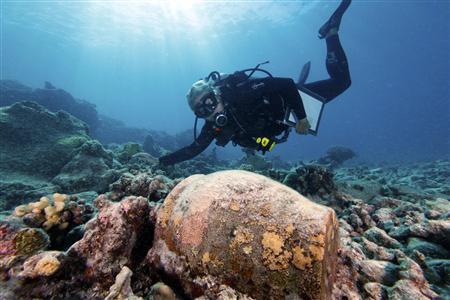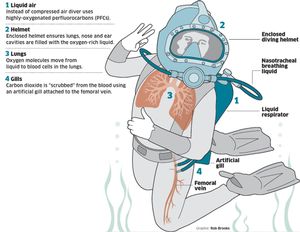The wreck of the whaling ship, Two Brothers, was discovered by maritime archaeologists 600 miles northwest of Honolulu. The ship, captained by George Pollard, Jr., went down on the night of February 11, 1823 after striking a reef in about ten feet of water in a poorly mapped area known as the French Frigate Shoals. Nearly two centuries later the warm ocean waters of the Pacific has reclaimed most of the wooden ship but archaeologists were able to recover several artifacts including harpoons and some of the cooking pots used by the whalers to turn whale blubber into oil.
archaeologists were able to recover several artifacts including harpoons and some of the cooking pots used by the whalers to turn whale blubber into oil.
Dr. Kelly Gleason with a ginger jar from the shipwreck Two Brothers.
Photo by Greg McFall/NOAA
Unfortunately this was not the first ship Captain Pollard had lost at sea. His first command was the whaler, Essex, which was rammed and capsized by a sperm whale. The incident inspired Herman Melville to pen the great American novel, Moby-Dick. After the sinking of the Essex Pollard and his crew were adrift at sea for three months with no food or water, resorting to cannibalism to survive, before finally being rescued.
The loss of the Two Brothers was much less eventful as they were sailing in the company of another whaling ship which had taken shelter nearby. All hands were recovered the next morning with no loss of life.
Dr. Kelly Gleason, the maritime archaeologist that led the discovery of the Two Brothers, originally found the ship's anchor in 2008 during a survey of the French Frigate Shoals but it wasn't until more artifacts were uncovered over the course of the next two years that confirmed the last resting place of the whaler.
Officials from the Papahanaumokuakea Marine National Monument announced the findings today, exactly 188 years to the date of the sinking of the Two Brothers. Gleason says the artifacts are scheduled to go on display at the marine monument's Discovery Center in Hilo.
In depth article can be found here and video interview with Dr. Gleason here.
 Sunday, August 7, 2011 at 5:13PM
Sunday, August 7, 2011 at 5:13PM  ISC
ISC 



